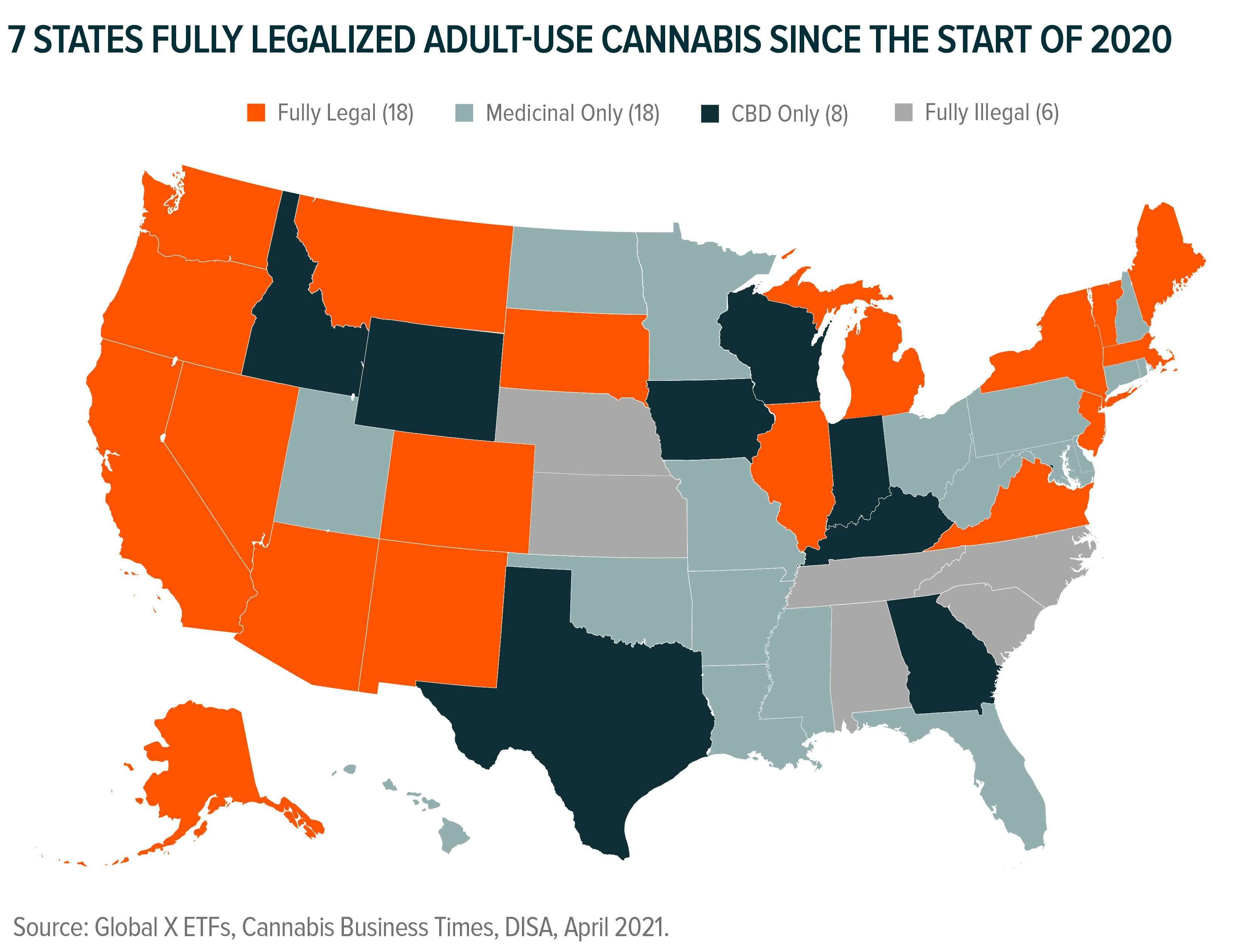Checking in on Cannabis (Part 1): State Legalization
ListenToday is April 20th, a date of cultural significance in the long history of cannabis. There are many guesses as to why this is this the case, but in the context of the budding global cannabis industry, today is a day when many take stock of legalization efforts and prune their predictions for the future.
The following is part 1 in 3-part blog series that will take the pulse of the global cannabis industry in 2021. This part highlights and evaluates progress toward legalization in U.S. states. Part 2 will look back at how existing markets performed over the past year. Part 3 will discuss the possibility of federal legalization in the U.S. and abroad.
2020 was a landmark year for the state-level cannabis industry in the U.S. and 2021 is shaping up to be one as well. Americans purchased $18.3B of cannabis products in 2020 – 71% more than in the year prior – amid COVID-19 lockdowns and social distancing.1 And since last November, 7 states have legalized recreational, or adult-use, cannabis, bringing the total to 18 plus Washington, D.C., though it remains federally illegal.
We believe that the U.S. cannabis market is at an inflection point where continued state legalization will further accelerate sales and help cannabis companies get their footing in advance of potential federal legalization. In the following, we will explore 2021 state-level legalization efforts and their implications, and also provide an update on state legalization that came from the 2020 election.
STATE-LEVEL LEGALIZATION EFFORTS ARE ACCELERATING IN 2021
Thus far in 2021, around 30M Americans have gained access to adult-use cannabis through state-initiated legalization in New York, Virginia, and New Mexico. Adult-use sales could roughly total more than $7B across these states as their respective markets mature (approximation of below forecasts, see sources).
New York
What happened? On March 31st, 2021, New York became the 15th state to legalize adult-use cannabis. This comes almost seven years after the state legalized cannabis for medical use and two years after non-medical possession was decriminalized.
Some components of the legislation became active immediately, making legal: the consumption of cannabis products by individuals aged 21 and older, the possession of up to 3oz of flower or 24 grams of concentrate, and public smoking wherever tobacco-use is permitted. Additionally, the bill’s signing marked the start of the state expunging non-violent cannabis-related criminal convictions.2
Other aspects will go into effect in the coming year as policymakers formulate and implement a regulatory framework. Within months, New Yorkers over 21 will be permitted to grow plants in their homes, a state regulatory body will be established, and the state’s medicinal cannabis program will expand.3 But cannabis consumers will have to wait until 2022 to purchase adult-use products in dispensaries, have products delivered to their homes, and to visit cannabis lounges.4
Projections: New York could very quickly become one of largest legal cannabis markets in the United States. Some estimate that legal and illicit cannabis sales in the state could reach $4.6B by the end of 2023 and $5.8B by the end of 2027.5 While regulatory clarity is still needed for proper assessment, the legal market’s share of sales could grow from 26% to 72% over this four year period, assuming New York’s rollout follows a similar path as other states’.6
State and local revenues from sales and excise taxes could reach $350M annually based on the rates set in the legislation. Additionally, the state expects that the industry will create 30k to 60k new jobs.7
Our Take: New York’s adult-use cannabis industry will likely become a critical determinant of market dynamics in other adult-use states, and possibly at the national and global levels if supportive federal cannabis reform materializes. New York is the 4th most populous state and it ranks 3rd in state-level GDP. This bodes well for the state purely from a consumption dollars standpoint, but more importantly, New York City is debatably the global epicenter of finance, commerce, and communication.
Proximity to these services could have a dramatic positive impact on the industry’s trajectory. For one, expanded resources could benefit companies with business in multiple states, or multi-state operators (MSOs), across all their involved markets. Non-MSOs could similarly take advantage, using these resources to scale their operations. And though federal law limits how financial services companies can work with the industry, a burgeoning New York cannabis market could push institutions to back the SAFE Banking Act legislation which could ease restrictions.
In our view, the state’s ten existing operators with medicinal licenses will see an outsized degree of success compared to MSOs and other operators who have yet to establish a presence in New York. The legislation grants existing medical licensees two licenses for adult-use stores, removing several initial barriers to entry. It also allows them to remain vertically integrated and recognize revenues from retail and wholesale channels, while new entrants must declare themselves as either retail or wholesale.8

Virginia
What happened? In April 2021, Virginia lawmakers voted to legalize adult-use cannabis by this July, making Virginia the first southern state to do so. This comes less than two years after the legislature approved a formal medicinal industry and decriminalized possession of the plant in small amounts.
Under the law, Virginians aged 21 and older will be allowed to consume cannabis products, possess up to an ounce, and grow up to four plants in their homes. Additionally, those with sentences from marijuana convictions can petition to suspend or modify them.9 Retail adult-use sales are further out – the approved legislation is targeting the first day of 2024. When this commences, the state will collect revenues from a 21% tax on adult use sales.
Projections: A November 2020 state-led impact report found that a mature adult-use market in Virginia could be worth $628B to $1.2B annually, generating up to $274M in tax revenues per year.10 Further analysis shows that the industry could also create up to 18,000 jobs.11
Our Take: Assuming implementation follows the path paved by April’s legislation, we think it is reasonable to expect that adult-use sales and respective state revenues align with mature-market projections by 2030. Federal cannabis reform could accelerate the market’s maturation, though it is uncertain how this would materialize and what the implications of it could be.
Most significant is that Virginia is the first southern state to legalize adult-use cannabis. We expect additional southern states to follow suit, with many of them likely to first legalize medicinal cannabis. Just last fall, Mississippi voted to legalize medicinal use cannabis, and as of April 2021 Alabama, North Carolina, Texas, Florida, and South Carolina have cannabis-related bills pending with their respective state legislatures. Obstacles to legalization certainly exist in the region, but we think that support from constituents and interstate competition will eventually lead to positive outcomes for the cannabis industry.
New Mexico: On April 12th, 2021, New Mexico Governor Michelle Grisham signed the Cannabis Regulation Act into law, making New Mexico the 18th state to legalize adult-use cannabis. The Act legalizes the purchase and possession of up to 2 ounces of flower, 16 grams of concentrate, and 800mg of THC-infused edibles for adults aged 21 years and older. Retail sales will likely have to wait until 2022, but in the meantime New Mexicans can grow up to 6 plants in their homes (12 per household).12 According to the Office of the Governor, adult-use first year sales could reach $318M, generating $20M in revenues for the state. The industry could create over 11,000 jobs as it matures.13
Notable Pending Efforts (as of April 18, 2021)
- Minnesota: House committees are currently assessing a bill to legalize the use and possession of up to 1.5 ounces of recreational cannabis. The bill has advanced through 7 committees and the house could vote on it in May.14 Governor Tim Walz is in favor of the plan.
- Rhode Island: The state’s senate is evaluating multiple proposals to legalize adult-use cannabis.15 Legalization is seen as a top priority for many leading Rhode Island legislators and Governor Dan McKee.
- Connecticut: A Bill to legalize and regulate adult-use cannabis passed through the state’s judiciary committee on April 6th and is likely heading the senate.16
- Delaware: The state’s House Health and Human Development Committee approved a bill to legalize and regulate adult-use cannabis on March 24th. It is currently with the House Appropriations Committee.
THE 2020 STATE ELECTIONS MOVED THE NEEDLE ON CANNABIS REFORM
Cannabis policy reform was a defining theme of the 2020 State Elections.
Varying degrees of legalization appeared on 5 state election ballots, with voters approving measures in each case. Arizona, New Jersey, and Montana voted to legalize cannabis for recreational use; South Dakota approved it for both recreational and medical use; and Mississippi legalized it for medical use.

New Jersey
What happened? In November 2020, New Jersey voters approved an amendment to the state constitution that legalizes the use and possession of recreational cannabis for adults over age 21, as well as the cultivation, processing, and sale of retail cannabis.17 Three months later, in February 2021, Governor Phil Murphy signed three cannabis reform bills into law, legalizing a regulated adult-use industry and decriminalizing the use and possession of up to 6 ounces of unregulated product.18 Sales likely won’t begin until 2022 as the state formulates a regulatory framework for retail cannabis sales.
Projections: New Jersey’s adult-use market could capture as much as $773M of sales from its existing illicit market by the end of 2022. This could grow to $1.8B by 2025, creating 22,000 jobs in the process.19,20 The state expects to collect $126M annually from related taxes.21
Arizona
What happened? 10 years after voting to legalize medical cannabis, Arizona voters approved legislation to legalize an adult-use market. Proposition 207 permits recreational cannabis use and possession of up to 1 ounce of cannabis flower for adults over age 21.22 The law also allows Arizonans to cultivate up to 6 cannabis plants in their homes.
Unlike other states, Arizona moved to implement all aspects of the law almost immediately. Retail sales began only two months later on January 22nd, with sales reaching $2.9M within 10 days.23 At that point the state had granted adult-use licenses to 73 of its existing medical operators adult-use licenses.24 As of March 15, 2021, all 130 existing medical establishments were permitted to sell recreational product.25
Projections: Arizona adult-use sales could reach $300M by the end of 2021, on the back of a speedy rollout and existing infrastructure. Some projections show that this could reach between $1.3B and $1.5B by 2025, but much is dependent on the ability to grant new licenses.26 The law limits the number of licenses granted to adult-use only establishments to 1 per every 10 registered pharmacies. Based on current licensing, this would cap the number of adult-use establishments at 165-170.27
South Dakota
What happened? In November, 69% of South Dakotans voted for Measure 26, which legalizes medical marijuana, and 54% approved of Amendment A, a proposal to legalize recreational cannabis in the state.28 Measure 26 calls for the Department of Health to begin reviewing applications for medical marijuana cards as well as licenses for growers and sellers by January 2021. Measure 26 is expected to activate on schedule.29 Amendment A’s future is uncertain, however. In February 2021, South Dakota’s Sixth Judicial Circuit Court ruled that it should not be ratified. This ruling is expected to be appealed to South Dakota’s Supreme Court.30
Obstacles & Implications: Amendment A is imperiled by the fact that the measure passed with a tighter margin of approval than any of the other initiatives discussed in this piece. Likewise, opponents of the legalization efforts have not been successful in halting activation of Measure 26, the relatively more popular initiative. In March 2021, South Dakota Gov. Kristi Noem’s proposal to scale back Measure 26 died in the state Senate, with state senators citing the high rates of approval rates among voters as a reason not to postpone the program.31 With nearly 70% approval, Measure 26 appears politically unassailable. The legal opposition to Amendment A targets technicalities in the construction of the amendment as well as how the measure was presented to voters. Such strategies mirror past efforts to repeal voter approved legalization efforts.
Montana: On January 1st, 2021, almost two months after Montana voters approved ballot initiatives to legalize adult-use cannabis, the relevant legislation was signed into law. Dual initiatives 190 and 118 legalize the possession, production, and commercial sale of recreational cannabis in the state of Montana. The state is currently on track to begin accepting license applications in October 2021, while recreational legal sales should commence in January 2022.32 Montana’s cannabis market is expected to generate $175M in sales and create 1,300+ new jobs by 2025.33
Mississippi: 74% of Mississippians voted to amend the state’s constitution to establish a medical marijuana program.34 As proposed, the program would be overseen by the state’s Department of Health and would allow Mississippians with one of 22 medical conditions to purchase cannabis beginning August 2021.35 However, Initiative 65 has experienced legal challenges as legislators have questioned whether the initiative unfairly favors the cannabis industry. On April 14, 2021, the Mississippi Supreme Court heard a challenge regarding the constitutionality of Initiative 65.36 A decision is expected to be delivered in May 2021. Regardless of this legal outcome, it is unlikely that Mississippi’s cannabis program will begin by the proposed August 2021 deadline.

CONCLUSION
While cannabis is still illegal on the federal level, more than 2/3 of the U.S. population lives in a state where a form of legal cannabis is available for purchase and almost 70% of Americans support full legalization.37 We believe that recent legalization efforts are indicative of more widespread state legalization that could accelerate the timeline for potential federal legalization. The continued growth of existing cannabis markets and introduction of new ones should give existing cannabis companies the opportunity to scale and optimize their operations, priming the industry to benefit from any further progress.
Related ETF
POTX: The Global X Cannabis ETF seeks to invest in companies across the cannabis industry. This includes companies involved in the legal production, growth and distribution of cannabis and industrial hemp, as well as those involved in providing financial services to the cannabis industry, pharmaceutical applications of cannabis, cannabidiol (i.e., CBD), or other related uses including but not limited to extracts, derivatives or synthetic versions.
Please click on the fund name for current holdings.


